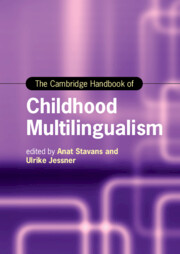Book contents
- The Cambridge Handbook of Childhood Multilingualism
- Cambridge Handbooks in Language and Linguistics
- The Cambridge Handbook of Childhood Multilingualism
- Copyright page
- Contents
- Figures
- Tables
- About the Editors
- Contributors
- Acknowledgments
- Multilingualism Is Not Bilingualism +1: An Introduction
- Part One Becoming and Being a Multilingual Child
- Part Two Cognition and Faculties in Multilinguals
- 5 Language and Thought in Multilingual Children
- 6 Multilingual Exposure and Children’s Effective Communication
- 7 Metalinguistic Awareness and Early Multilingual Learning
- 8 Code-Switching among Bilingual and Trilingual Children
- 9 Children’s Perception of Their Multilingualism
- 10 Multilingualism and Language Play
- Part Three Family Language Policy
- Part Four Language(s) and Literacy of Multilingual Children through Schooling
- Part Five Socialization in Childhood Multilingualism
- Part Six Multilingual Children’s Landscape
- Subject Index
- Country Index
- Language Index
- References
7 - Metalinguistic Awareness and Early Multilingual Learning
from Part Two - Cognition and Faculties in Multilinguals
Published online by Cambridge University Press: 18 August 2022
- The Cambridge Handbook of Childhood Multilingualism
- Cambridge Handbooks in Language and Linguistics
- The Cambridge Handbook of Childhood Multilingualism
- Copyright page
- Contents
- Figures
- Tables
- About the Editors
- Contributors
- Acknowledgments
- Multilingualism Is Not Bilingualism +1: An Introduction
- Part One Becoming and Being a Multilingual Child
- Part Two Cognition and Faculties in Multilinguals
- 5 Language and Thought in Multilingual Children
- 6 Multilingual Exposure and Children’s Effective Communication
- 7 Metalinguistic Awareness and Early Multilingual Learning
- 8 Code-Switching among Bilingual and Trilingual Children
- 9 Children’s Perception of Their Multilingualism
- 10 Multilingualism and Language Play
- Part Three Family Language Policy
- Part Four Language(s) and Literacy of Multilingual Children through Schooling
- Part Five Socialization in Childhood Multilingualism
- Part Six Multilingual Children’s Landscape
- Subject Index
- Country Index
- Language Index
- References
Summary
The relationship between early multilingual learning and metalinguistic awareness is a particularly intriguing one. Not surprisingly, research into the effects of multilingualism on children’s linguistic development and awareness of language has attracted a lot of attention over the past years and decades as studies have found both positive effects of multilingualism on the development of metalinguistic awareness, and also facilitative effects of metalinguistic awareness on language learning. In the recent literature, metalinguistic awareness has been linked to important qualitative changes in the language and learning processes of multilinguals.
- Type
- Chapter
- Information
- The Cambridge Handbook of Childhood Multilingualism , pp. 163 - 189Publisher: Cambridge University PressPrint publication year: 2022
References
- 1
- Cited by



